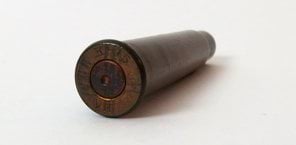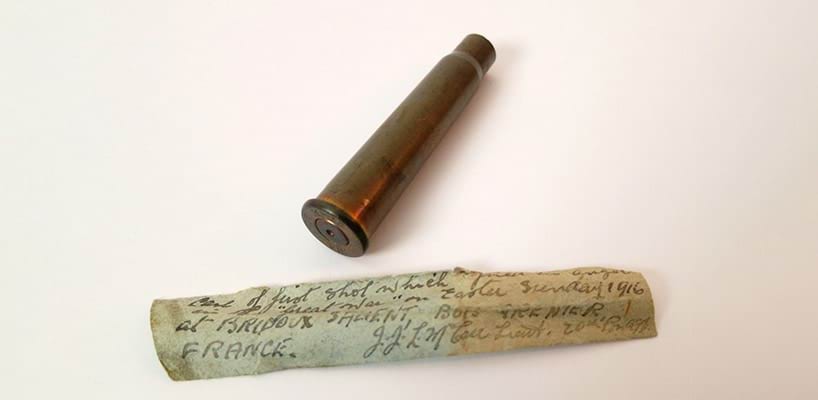
- Conflict:
- First World War (1914-18)
- Service:
- Army
by Katrina Nicolson
At first glance the spent brass cartridge looks no different to any other. Examination reveals the Roman numeral ‘VII’ and the alpha-numeric ‘K-15’ marked on the base of the casing, which indicate it is from a .303 cartridge for a Lee-Enfield rifle, manufactured in 1915 by Kynoch Ltd of Birmingham, England. Munitions like this were made in their billions during the First World War (1914–18); Kynoch alone made around 2.4 billion. What makes it significant is the tattered piece of paper carefully tucked inside. Inscribed in ink it reads:
Case of first shot which fired in anger In the “Great War” on Easter Sunday 1916 BRIDOUX SALIENT, BOIS GRENIER FRANCE. J.J.L. McCall Lieut. 20th Btn
Who was J J L McCall, and could this claim be true? John James Lawton McCall was a career army officer.
He enlisted in the Australian Permanent Military Forces, Corps of Staff Cadets, at the Royal Military College Duntroon on 7 March 1913. He remained there until, along with other class members, he graduated early for service abroad.
On 1 July 1915, McCall was appointed Lieutenant with the Australian Imperial Force (AIF) and in November that year he embarked for overseas service. In February 1916 he was transferred to the 20th Battalion AIF, as an Intelligence Officer.
By April his battalion, including many Gallipoli veterans, was having its first experience of Western Front trench warfare at Bois Grenier, south of Armentieres, France. This sector was known as the Nursery Sector as it was deemed a quieter area of the front, which would allow troops to acclimatise to conditions and gain experience in trench raiding. The battalion diary for 10 April records: ‘Officers visited the front line trenches to be familiar with working.’
On 23 April, Easter Sunday, the 20th Battalion was in the front line and under fire; one man was wounded. They relieved the 18th Battalion on 14 April, so the shot referred to is unlikely to be either the AIF’s or the 20th Battalion’s first. It therefore seems probable that this is Lieutenant McCall’s ‘first shot’. It was certainly common for officers in the front line to use a rifle, rather than their officer issue handgun. The designation ‘Lieut’ in the signature indicates he wrote the note soon after, because he was promoted Captain only six weeks later.
McCall went on to serve with distinction. He was mentioned in dispatches for his ‘valour, resource and initiative’, when on 5 May the battalion were the first Australians to experience a trench raid by German forces, and by war’s end he was a Brigade Major.
After the war, he served in the Permanent Military Forces and spent some time based in Melbourne.
McCall was from a family with strong military traditions, both his father and
grandfather served, which may have influenced his appreciation that this was an item worth keeping, and a moment worth recording. It is in his recording, a personal connection with a seemingly mundane object, manufactured in billions, that we find significance.
Author:
Katrina Nicolson has been a Research Officer with the Shrine of Remembrance since 2011. She has worked on many exhibitions including, The ‘Blood Tub’: Australians at Bullecourt, Pozieres, 1966: The Year that Changed the World, Brigadier Walter and Helena Cass, Indigenous Australians at War: from the Boer War to the Present, and is co-curator of the Shrine’s travelling exhibition Australia Will Be There: Victorians in the First World War (1914–19).
Updated

